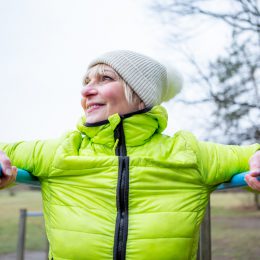Your Room-by-Room Guide to Preventing Falls
Make taking a tumble less likely to happen in your home with these safety suggestions.

You’ve probably already heard the unnerving statistics about the dangers of falling later in life. But it’s worth repeating: One in four people aged 65 or older fall every year, according to the Centers for Disease Control and Prevention (CDC). And as you age, your risk of serious injuries and fatalities from this type of accident increases too.
We get it: Many people don’t like the idea of changing their home or the way they usually do things. But small shifts can go a long way toward avoiding slips and trips.
“Many adults fail to report falls to doctors because they believe they are too young to need help,” says accessibility specialist Catia Garrell. She is an occupational therapist in Hawaii and an instructor at the University of Southern California (USC) Leonard Davis School of Gerontology.
Instead of seeing home modifications as an unnecessary hassle, think of them as insurance. A safer set-up will make it less likely that you will fall, and it makes you less fearful of falling, notes Julie Overton, of the USC Leonard Davis School of Gerontology. She manages the Executive Certificate in Home Modification Program.
If you live at home and want to stay there as long as you can, try these room-by-room suggestions from senior-living experts to help prevent slips and trips.
Add SilverSneakers to your wellness routine! Classes and events are happening daily at participating gyms, online through SilverSneakers LIVE, and at community centers near you. Activate your free online account to get started.
Your Bedroom
In a perfect world, you would feel safest in the space where you spend most of your time. Unfortunately, fall statistics reveal that bed falls, when a person falls or slips out of bed, are not uncommon.
Tripping when you’re not wearing glasses, feeling groggy or rushing to the bathroom can also lead to unwanted spills. In fact, when a study in the Journal of Lifestyle Medicine looked at emergency room visits related to at-home falls, it found that most accidents occurred in the bedroom, bathroom or on the stairs.
Try these tips to keep your sleeping quarters more secure:
- Keep the floor clear of clutter. This is key to preventing falls when you’ve just woken up or gotten out of bed.
- Remove oversized or unnecessary furniture. It can make it trickier to navigate the room.
- Add a night light. This can help you avoid stretching or getting up to turn on a lamp or light switch — when a fall can happen. Alternatively, use a motion or voice-activated system to turn lights on and off, says physical therapist Monique Caruth. She is the chief executive officer of Caruth Staffing Agency, a rehabilitation staffing agency, and a spokesperson for the American Physical Therapy Association.
- Place bright tape on any places where the floor surface changes, usually around a doorway or threshold, as a warning to step carefully.
- Make sure the pathway to the restroom is always clear. Urinary incontinence and urgency at night are common problems later in life.
- Consider adding bedrails to prevent bed falls.
Your Bathroom
Water, tiles, soap and hard surfaces can make the bathroom hazardous. According to the CDC, injury rates related to using tubs and toilets increase with age. See if you can make any of these adjustments:
- Add non-skid bathmats inside the tub or shower.
- Mop up water that splashed out of the shower or sink right away.
- Add a bath seat inside the shower stall.
- Add grab bars near the toilet. Also put them near the shower or tub entryway and by the faucet handles.
- If possible, remodel the bathtub and turn it into a walk-in tub or shower. Because body strength gradually reduces with age, most everyone will eventually have difficulty getting in and out of the bathtub. “The best thing to have is a flat, curbless shower,” says Garell.
Your Stairs
As the Journal of Lifestyle Medicine study shows, stairs are infamously dangerous for older folks. A simple slip can turn into a very long tumble, which can result in more serious injuries. Help keep your stairs safer with these tweaks:
- Stop placing any objects on or around the stairs.
- Use handrails. If you only have a handrail on one side, consider having another one installed, so you have access to handrails on each side of your body. “You might add grab bars at the beginning of the stairs to help pull yourself up,” says Caruth. Some people add handrails in the hallways, too. Also don’t forget to tighten loose handrails.
- Make sure your stairs and landings have adequate lighting.
- Consider putting no-slip strips or carpet on the stair steps.
- Remove throw rugs from the landing or top of the stairs.
Your Kitchen
Strategic organizing can help improve safety in the heart of your home. Here’s expert advice on how to fall-proof this space:
- Mop up spills as soon as they happen, so you don’t slip on them later.
- Stash frequently used items in a low, convenient spot to reduce the need to bend, stretch or use a step stool.
- Consider adding a lazy Susan revolving tray to maximize the space that you can reach easily.
- Buy a durable grabber stick for items still just out of reach. But only use it for lightweight things, so a jar of pasta sauce doesn’t come crashing down on your head.
- Pay attention to any transitions from hardwood floors or carpeting to vinyl or linoleum. Mark them with tape if necessary.
Your Living Room
Keep this space cozy and safe by looking out for these common trip-and-fall dangers:
- Remove or downsize any bulky furniture that is not essential.
- Secure wires and cords so these trip hazards are out of your way.
- Relocate or remove boxes, piles of books, footrests or side tables so you can keep pathways clear. If relatives and friends can’t pitch in, you may be eligible to work with a social worker who can help you find short-term, affordable personal organizing help. Check out local options using Eldercare Locator.
- Remove throw rugs. Caruth says if you really want to keep them, consider securing them to the floor with double-sided tape.
- Ensure that the living room is well-lit and that the lighting is easy to turn on and off.
Making Larger Modifications
The above tips are mostly simple, inexpensive fixes. But you may eventually want more significant home modifications, particularly if you need to use a walker or wheelchair.
If you own your home and can afford them, larger fixes can be worth the investment: One study suggests that home modifications conducted by health care professionals, such as occupational therapists, can reduce the risk of falls in older adults. (These types of sessions with occupational therapists are often covered by insurance, so be sure to ask your doctor for a referral.) Upgrades may also increase your quality of life, lengthen the time that you can stay at home, and even boost the value of your property.
Subscribe to our newsletter
It's quick and easy. You could be one of the 13 million people who are eligible.
Already a member? Click to discover our 15,000+ participating locations.
Follow Us
If you rent, your landlord must allow you to make accessibility modifications, per laws outlined in the Fair Housing Act and Americans with Disabilities Act. But they don’t have to pay for them.
Where to Find Reliable Home Upgrade Help
If you pursue remodeling or serious structural modifications, be sure to consult these consumer resources to find well-regarded, qualified professionals:
- Your local Area Agency on Aging (AAA) is a nonprofit responsible for providing programs, information and services for older adults. To reach one near you, call Eldercare Locator at 1-800-677-1116. They can help connect you to your community AAA. Many AAAs administer fall prevention and home modification programs.
- Homemods.org is the website of the Fall Prevention Center of Excellence at USC’s School of Gerontology. It features many useful tools, including a national directory of resources.
- The National Council on Aging offers a map of fall prevention partners and programs across the country.
Recommended reading: Fall Prevention: The SilverSneakers Guide
Whole-Body Wellness Challenge: 5 Exercises to Help Prevent Falls
Prevent Falls at Home: Your 6-Step Plan
See our sources:
Fall risk statistics: Centers for Disease Control and Prevention and National Safety Council
Home safety modifications: National Council on Aging
Rooms where you’re most likely to fall: American Journal of Lifestyle Medicine
Bathroom injury rates: Centers for Disease Control and Prevention
Aging in place: USC Leonard Davis School of Gerontology
Home modification research: Cochrane Reviews
Tenant rights: U.S. Department of Housing and Urban Development
Activate Your FREE SilverSneakers Online Account
Get hundreds of free SilverSneakers On-Demand videos and stay in touch with us by creating your free online account. You don’t have to be a SilverSneakers member to get on-demand workout videos, health and fitness tips from SilverSneakers, and more.
SilverSneakers members can go to thousands of nationwide gyms and fitness locations, plus take SilverSneakers LIVE online classes led by specially trained instructors and designed for all fitness levels and abilities – at no additional cost. If you have a Medicare Advantage plan, it may include SilverSneakers. Check your eligibility here.
Already a member? Get your SilverSneakers member ID, search for locations near you, and all the health and wellness resources you need by logging in to your online member account here.





